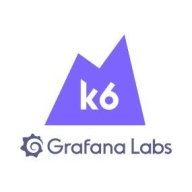

Apache JMeter and k6 Open Source are leading players in load testing tools. JMeter is favored for its comprehensive testing capabilities, while k6 appeals with its modern scripting environment and developer-centric approach.
Features: Apache JMeter provides extensive protocol support such as HTTP, HTTPS, FTP, JDBC, and JMS. It includes a robust set of plugins and integrations for complex testing scenarios. Meanwhile, k6 Open Source offers a JavaScript-based scripting environment, easy CI/CD pipeline integration, and cloud execution capabilities.
Ease of Deployment and Customer Service: JMeter, a Java-based tool, is easily deployed across platforms but may need extra configuration for advanced setups. k6 Open Source is simple to deploy with a standalone binary and benefits from comprehensive documentation, making the initial setup straightforward.
Pricing and ROI: Apache JMeter, being free and open-source, offers significant cost savings and high ROI if existing infrastructure meets its requirements. k6 Open Source also has a free tier, with premium features requiring investment. Its ROI is often seen in quicker test cycles and integration efficiencies.


Apache JMeter is an open-source Java application that tests load and functional behavior and performance in applications. Created initially to test web applications, it has expanded its functionality to test other functions. For instance, you can test a server to see how efficiently it works and how many user requests can be handled simultaneously.
You can use JMeter to test functional performance and regression tests on different technologies. This Java desktop application has an easy-to-use graphical interface which uses the Swing graphical API. You can run JMeter on any environment that accepts a Java virtual machine, such as Windows, Linux, and Mac.
What protocols does JMeter support?
How does JMeter work?
JMeter sends requests to a target server by simulating a group of user requests. Then it collects and calculates statistics on the performance of the target. This target can be a server or an application.
You can test the performance of static resources, such as JavaScript or HTML, and dynamic resources, such as JSP, Servlets, and AJAX. It is also helpful to determine how many concurrent users your website can handle.
There are two main tests you can carry out with JMeter: load test and stress test. The load test models expected usage of a server by simulating multiple users accessing the web server simultaneously. The stress testing aims to find the maximum load capacity of the server or application.
Apache JMeter Key Features
Apache JMeter Benefits
The JMeter extensible core has numerous benefits:
Reviews from Real Users
Stephen B., I.T. Architect, Analyst, and Developer at an educational organization, says, "The scripting ability is most valuable. It is easy to use. There is a UI, and you can go in there and figure those things out. After you've got a good set of tests, you basically have a scripted document that you can grab and execute in a pipeline. It is pretty quick to set up, and you can scale it and version control it."
"I like the fact that JMeter integrates well with other tools," adds the Founder and Principal Consultant at a tech services company.
A Quality Engineering Delivery Leader at a financial services firm says, “The performance of the solution is excellent. They have designed the product so that it is very easy to configure. You can basically do anything you like with the product. It's not very restrictive. We like the fact that the technology is open-source.”
Load Impact offers three main features:
We monitor all Load Testing Tools reviews to prevent fraudulent reviews and keep review quality high. We do not post reviews by company employees or direct competitors. We validate each review for authenticity via cross-reference with LinkedIn, and personal follow-up with the reviewer when necessary.